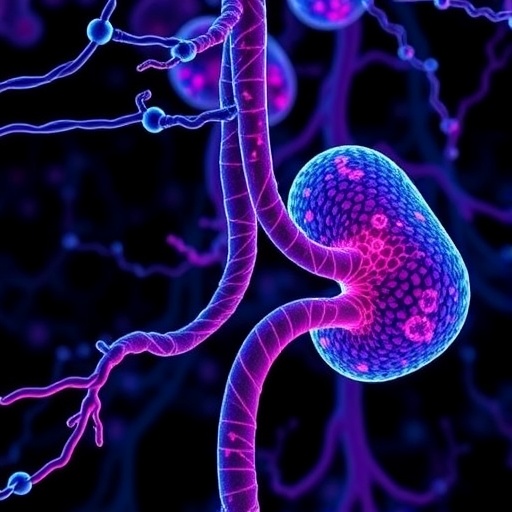Radiomics and machine learning have emerged as pioneering tools in the fight against pancreatic cancer, one of the most deadly malignancies afflicting the digestive system. A newly published study in BMC Cancer reveals that the use of radiomics to analyze contrast-enhanced computed tomography (CECT) images can preoperatively predict perineural invasion (PNI), a key factor associated with poor outcomes in pancreatic cancer patients. This breakthrough could revolutionize how clinicians approach treatment planning and prognostic assessments in this devastating disease.
Pancreatic cancer remains notorious for its aggressive nature and dismal survival rates, with five-year survival lingering in the single digits globally. One of the primary challenges in managing this cancer is the frequent presence of perineural invasion, wherein cancer cells infiltrate the nerves surrounding the pancreas. PNI has been consistently linked to worse overall survival and increased recurrence after surgical resection. Thus, early and accurate identification of PNI status before treatment is essential for tailoring optimal therapy.
Radiomics offers a noninvasive approach to unlocking hidden features in medical images that are imperceptible to the naked eye or conventional radiological assessment. By extracting quantitative data from CECT scans, advanced algorithms can detect subtle textural and structural changes within the tumor environment. Leveraging these insights, the study team sought to build a machine learning model capable of discerning the likelihood of PNI solely using preoperative imaging.
The investigation enrolled 167 patients diagnosed with pancreatic malignancies who underwent surgical resection with curative intent. Using sophisticated computerized tools, the researchers extracted a staggering 851 radiomic features from the tumor regions of interest across high-resolution CECT scans. Through a rigorous feature selection process, 22 of these variables demonstrated the strongest statistical association with PNI and were employed to construct a comprehensive radiomic score, or RadScore.
To identify the best computational method, the team rigorously evaluated seven different machine learning algorithms on the extracted features. The Gaussian naive Bayes model emerged as the top-performing classifier, delivering outstanding predictive accuracy. It achieved an area under the receiver operating characteristic curve (AUC) of 0.899 in the training cohort and 0.813 in an independent validation cohort, underscoring its robustness and generalizability.
Beyond imaging data, key clinical indicators were integrated into the analytical framework to enhance prediction capabilities. Variables such as maximum tumor diameter, serum carbohydrate antigen 19-9 (CA-199) levels, blood glucose concentration, and lymph node metastasis were identified through multivariate analysis as independent risk factors for perineural invasion in pancreatic cancer.
Incorporating these clinical parameters alongside the radiomic features, the researchers built an integrated predictive model. This combined approach demonstrated superior diagnostic performance, with AUC values rising to 0.945 in the training set and 0.881 in the validation cohort. Decision curve analysis further validated the model’s clinical utility, indicating substantial net benefit in preoperative PNI prediction for patient management.
A striking element of this work is the application of SHapley Additive exPlanations (SHAP) to interpret model outputs. SHAP provides a transparent, interpretable framework for understanding how individual features influence predictions, mitigating the “black box” problem that often plagues machine learning applications in medicine. This transparency bolsters clinician trust and fosters wider acceptance of AI-driven tools.
The implications of this study are profound. With accurate noninvasive identification of perineural invasion prior to surgery, oncologists can better stratify patients by risk and personalize treatment strategies. For example, patients predicted to have a high likelihood of PNI may benefit from more aggressive multimodality therapy or closer postoperative surveillance to improve outcomes.
Furthermore, this research underscores the growing synergy between radiomics and machine learning as revolutionary assets in precision oncology. By extracting and synthesizing complex imaging and clinical data, these approaches transcend traditional diagnostic paradigms, providing deeper biological insights and improving predictive accuracy.
While promising, the authors acknowledge challenges remain before widespread clinical implementation. Larger multi-institutional studies are needed to validate these findings across diverse populations and imaging platforms. Additionally, integrating radiomics into standard workflows will require streamlined software tools and clinician training.
Nevertheless, this investigation marks a significant leap forward in pancreatic cancer management by harnessing the power of advanced computation and imaging. It exemplifies how interdisciplinary collaborations can yield novel diagnostic innovations with the potential to save lives and alleviate suffering from this formidable disease.
As biomarker-driven personalized medicine advances, future studies may expand radiomics analyses to other imaging modalities or combine with molecular profiling for even greater predictive power. The ongoing evolution of machine learning algorithms will further refine and democratize these cutting-edge diagnostic tools.
In summary, the development of a robust radiomic and clinical feature-based machine learning model offers a transformative approach to predicting perineural invasion in pancreatic cancer. This innovation promises to optimize treatment decisions and prognostic assessments, heralding a new era in pancreatic oncology characterized by personalized, data-driven care.
The convergence of radiomics with explainable AI paves the way for next-generation diagnostic precision and improved patient outcomes in one of medicine’s most challenging cancers. As such, this landmark study sets a compelling precedent and sparks hope for better therapies and survival in pancreatic cancer.
Subject of Research: Using radiomics and machine learning to predict perineural invasion in pancreatic cancer.
Article Title: Radiomics analysis using machine learning to predict perineural invasion in pancreatic cancer.
Article References:
Sun, Y., Li, Y., Li, M. et al. Radiomics analysis using machine learning to predict perineural invasion in pancreatic cancer. BMC Cancer 25, 1480 (2025). https://doi.org/10.1186/s12885-025-14806-5
Image Credits: Scienmag.com




